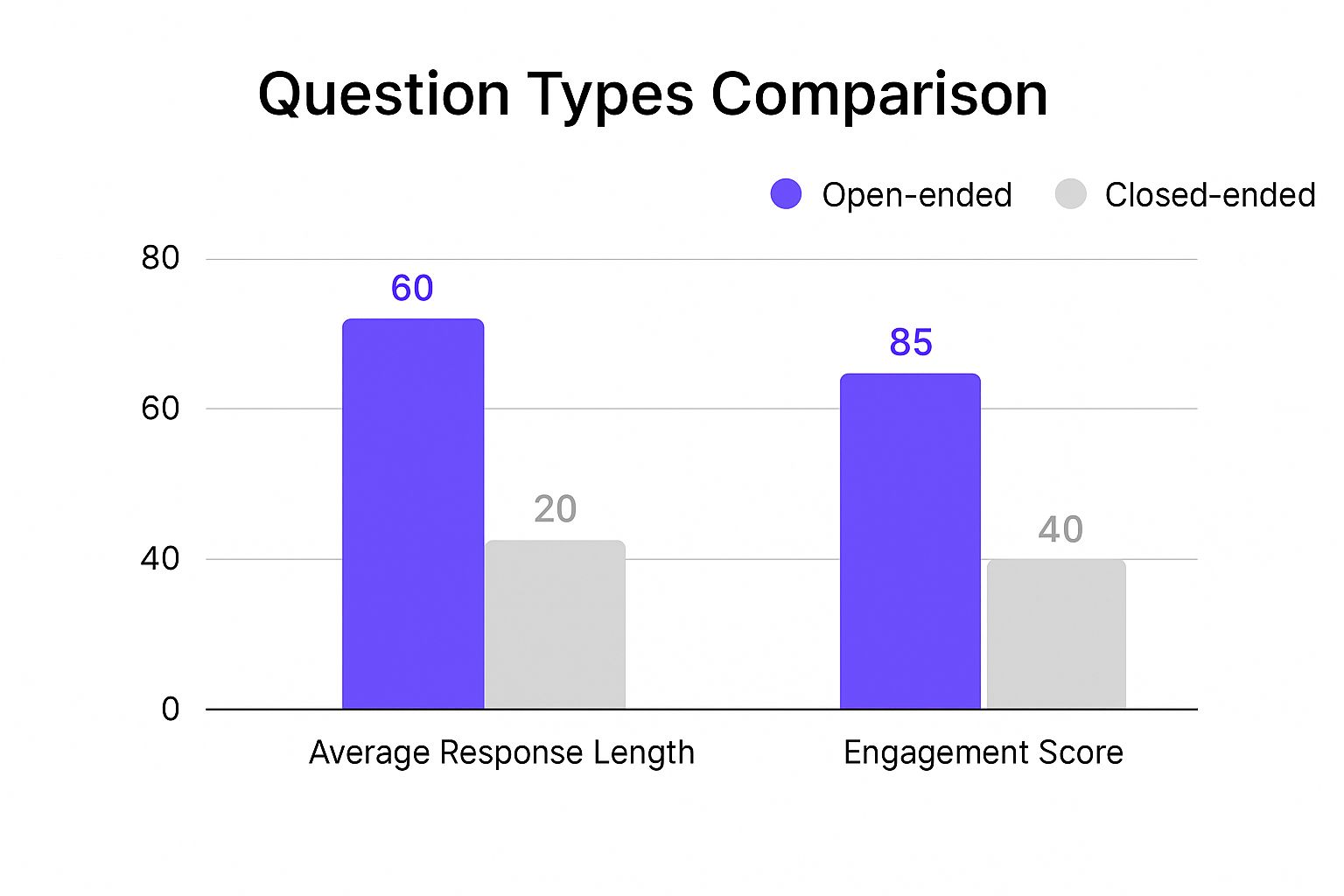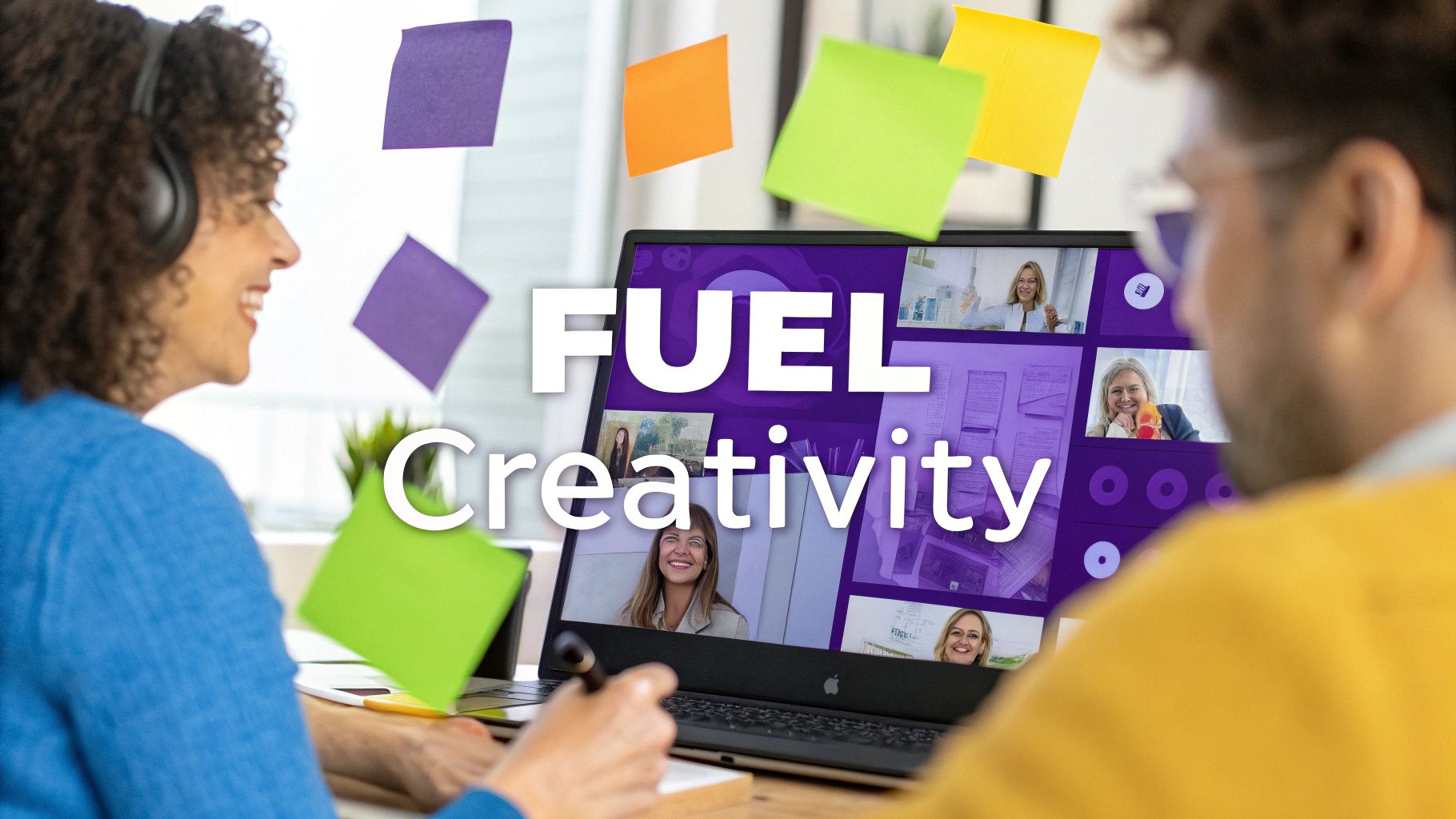If you want better, more thoughtful answers from your team, you need to learn how to ask open-ended questions. These are the kinds of prompts that can’t be answered with a simple “yes” or “no.” Instead, they demand detailed responses and pull deeper insights out of people. It’s a small change in how you frame things, but it makes a world of difference.
Why Your Best Ideas Remain Unspoken
Ever walked away from a brainstorming session feeling like you barely scratched the surface? The problem usually isn’t a lack of creativity—it’s the questions that kick off the conversation. So many meetings get torpedoed from the start by closed-ended questions.
These are the real conversation killers. Think about questions like, “Did everyone like the proposal?” or “Is this project on track?” They steer the conversation toward a simple “yes” or “no,” effectively shutting down any real discussion before it begins. Your team members might have valuable concerns, complex thoughts, or even brilliant alternatives, but a closed question leaves them no space to share. What you get instead is often awkward silence or a round of half-hearted nods.
The Anatomy of a Stifled Conversation
Picture a team lead asking, “Are we all in agreement on this new marketing slogan?” This kind of question puts pressure on everyone to conform. Someone who feels hesitant or has a completely different idea is much less likely to voice it. They’re cornered into either agreeing or creating friction by disagreeing, with no easy way to explain why.
This is exactly where asking an open-ended question can completely change the dynamic.
Instead, imagine the lead asking, “What are your initial thoughts on this new marketing slogan?” It’s no longer a demand for consensus; it’s an invitation. You’re asking for opinions, gut reactions, and detailed feedback. The door is now open for a much richer conversation.
To really see the difference, it helps to put them side-by-side.
Open vs Closed Questions: A Quick Comparison
Closed-ended questions are great for getting quick, factual answers, but they stop conversations cold. Open-ended questions, on the other hand, are designed to start them. Here’s a simple breakdown:
| Question Type | Typical Starting Words | Example Question | Expected Answer Type |
|---|---|---|---|
| Closed-Ended | Are, Is, Did, Will, Have | “Did you complete the report?” | A simple “Yes” or “No” |
| Open-Ended | What, How, Why, Describe | “What challenges did you face with the report?” | A detailed explanation |
By starting with words like “What” or “How,” you automatically prompt for more than a one-word answer. It’s a simple trick that encourages people to elaborate, which is precisely what you want in a creative setting.
“A well-crafted, open-ended question is the natural vehicle to achieve breakthroughs. When you invite employees to share more, inevitably, new insights will surface.”
This isn’t just about making meetings feel more collaborative—it produces results you can actually measure. When you make the switch, you’ll see both the length of responses and the level of engagement shoot up.

As you can see, open-ended questions don’t just get slightly better answers; they generate significantly longer responses and more than double the engagement. Moving from conversational dead-ends to dynamic dialogue is the first real step toward unlocking your team’s best ideas.
The Hidden Power of Unscripted Answers

The real magic of using open-ended questions goes way beyond just running a good brainstorming session. It taps directly into how people naturally think and communicate. When you ask a closed question like, “Is this the best approach?” you’re accidentally putting up guardrails on the conversation. You’ve defined the box, and your team will do their best to think inside it.
This subconscious steering can smother real creativity. Someone on your team might have a brilliant, completely different idea, but the way you phrased the question sends a clear signal: you’re looking for a simple yes or no on the current path. The most game-changing ideas are almost always found just outside those lines.
Uncovering a Goldmine of Ideas
Great facilitators have always known this, but the research backs it up, too. Open-ended questions consistently pull out a richer, more genuine range of thoughts from people. One foundational study found that a staggering 60% of answers to an open-ended question were completely different from the pre-set choices offered in a similar closed-ended version.
Think about that for a second. That’s how many valuable perspectives we risk losing just by how we frame our questions. When you shift to genuine, unscripted inquiry, you’re creating the space for those unexpected gems to surface.
By asking questions that don’t have a ‘right’ answer, you’re not just gathering feedback; you’re inviting co-creation. You’re signaling that every perspective is valuable, which builds trust and encourages people to really engage.
This approach is how you uncover surprising customer needs, spot potential breakthrough features, or identify operational snags no one else has noticed. To make sure you capture all these detailed thoughts, especially when ideas are flowing fast, consider integrating speech-to-text into your workflow. It turns spoken ideas into organized text without killing the momentum.
This technique is a perfect fit for methods like brainwriting. To see exactly how this works in practice, you can dive into our complete guide here: https://www.remotesparks.com/what-is-brainwriting/. It all starts with changing how you ask.
How to Craft Powerful Open-Ended Questions

Alright, let’s get practical. Knowing you should ask open-ended questions is one thing; actually doing it well is another. The secret I’ve found is to start with powerful question stems—think of them as conversational keys that unlock creative thinking instead of just getting a simple “yes” or “no.”
For instance, starting a question with “How might we…” or “What if we…” instantly signals to everyone that it’s time to brainstorm, not just report facts. Another one I use all the time is, “Tell me more about…” It’s a gentle way to ask for more detail without putting someone on the spot.
From Closed to Open: A Practical Shift
It’s amazing how a small tweak in wording can completely change the direction of a conversation. Let’s say your team is giving feedback on a new product feature.
- Closed Question: “Do you like the new dashboard?” This is a dead end. You’ll get a “yes” or “no,” and that’s about it.
- Open Question: “What are your first impressions of the new dashboard?” Now you’re inviting opinions, personal experiences, and the kind of constructive feedback you actually need.
A classic mistake I see people make is bundling questions together. Asking, “What do you think of the new marketing campaign, and do you think it will hit its targets?” just creates confusion. Unpack your questions. Tackle one idea at a time to keep the discussion clear and productive.
The real art is framing a question that’s broad enough to invite creativity but focused enough to stay on track. You want to guide the conversation, not control it.
Questions That Spark Innovation
Learning to craft great questions is a skill that pays off everywhere, from brainstorming sessions to gathering team feedback. In fact, many of the same principles apply when you’re trying to write effective employee engagement survey questions that get you honest, detailed answers.
Here are a few of my go-to starters that you can steal for your next meeting:
- For Problem-Solving: “What obstacles do we need to consider with this approach?” This is perfect for uncovering risks before they become problems.
- For Creative Brainstorming: “How might we achieve [goal] if we had unlimited resources?” This classic technique removes those mental barriers and encourages truly big ideas.
- For Process Improvement: “Describe the ideal workflow for this task from your perspective.” This taps into your team’s direct experience and focuses on solutions.
When you start using these kinds of questions, you’ll see your brainstorming sessions transform. If you’re looking to pair these questions with more structured techniques, check out our guide on https://www.remotesparks.com/brainstorming-methods/ for frameworks that can take your idea generation to the next level.
Engaging Your Remote Team with Better Questions
Brainstorming with a remote team is a completely different ballgame. When people aren’t physically in the same room, it’s all too easy for them to start multitasking, get distracted, and quietly disengage. Getting real, thoughtful participation becomes a major uphill battle.
This is where you, as a leader, have to be much more intentional. The secret weapon? Asking better questions. When you pose a truly open-ended question in a remote meeting, you’re doing more than just asking for ideas—you’re actively pulling people back into the conversation. A question that requires a unique, considered response makes it nearly impossible for someone to just tune out.
Fostering Engagement From a Distance
I’ve found one of the most effective strategies is to pair a powerful question with an asynchronous tool. Think about posting a prompt on a digital whiteboard before the meeting even starts.
Something like, “How could we completely re-imagine our customer onboarding to feel surprisingly personal?” This gives everyone the time and space to mull it over and contribute without pressure, which often leads to much deeper insights.
For live virtual meetings, ditch the unstructured free-for-all. A simple ’round-robin’ approach can work wonders. Instead of a vague “Any ideas?”, try posing a specific, creative question and then go around the virtual room, giving each person the floor.
- The Old Way: “Does anyone have ideas for our next marketing campaign?” This is often met with crickets.
- A Better Way: “If we had to design a campaign with a zero-dollar social media budget, what creative avenues could we explore?” Now you’re sparking genuine problem-solving.
This small tweak completely shifts the dynamic from a passive listening session into an active, collaborative one. If you want to dig deeper into this, our guide on how to engage remote employees has a ton of practical strategies for building that connection.
In a remote setup, your questions are the main tool you have for creating psychological safety. A good question tells your team that every idea is welcome, not just the ones from the loudest person in the virtual room.
Of course, asking great questions is just one piece of the puzzle. It’s also worth looking into additional ways to promote remote team connection to really strengthen your team’s bond.
Avoiding Common Pitfalls and Team Fatigue

While it’s great to ask open ended questions, they aren’t a magic wand. If you rely on them too much, you’ll run headfirst into a very real problem: team fatigue. These questions require serious mental heavy lifting and abstract thinking, which takes a toll.
Imagine a meeting where every single agenda item is a massive, open-ended query. Instead of sparking brilliant ideas, you’ll likely see glazed-over eyes and get short, tired answers. It’s a classic case of too much of a good thing. People just don’t have the cognitive bandwidth to think expansively for an entire hour.
This is especially true for surveys. While they offer rich insights, piling on open-ended questions is a recipe for poor data. Research confirms that it creates a burden for respondents, leading to a spike in “don’t know” answers or people just skipping them altogether. It’s a delicate balance.
Knowing When to Go Closed
The real skill is knowing when to deploy these powerful questions with purpose, not just by default. Sometimes, a simple, closed-ended question is exactly what you need to keep things moving.
Think about it: you don’t need a deep, philosophical discussion to confirm a deadline. A quick “Are we on track to deliver by Friday?” works perfectly. For routine check-ins or quick confirmations, a direct question that gets a “yes” or “no” respects everyone’s time and mental energy.
Key Takeaway: The goal isn’t to eliminate closed questions but to create a strategic blend. Use open questions for exploration and discovery, and closed questions for confirmation and alignment.
This balanced approach keeps your meetings productive and prevents the brain-drain that sets in from constant abstract thinking. It ensures your team stays energized for the moments that truly demand their full creative power.
For more on navigating these challenges, our guide on creative problem-solving techniques offers some great frameworks for structuring your sessions effectively.
Answering Your Questions About Open-Ended Questions
Once you start using open-ended questions, a few practical questions always seem to pop up. Let’s walk through some of the common ones I hear from teams who are just getting the hang of this.
How Many Open-Ended Questions Are Too Many?
There isn’t a hard and fast rule here, but it’s all about quality, not quantity. If you throw too many broad questions at your team in one sitting, you’ll see the energy drain right out of the room. It’s a classic case of decision fatigue.
My advice? Stick to one or two really well-crafted questions for each major topic on your agenda. This keeps everyone sharp and the conversation on track.
It’s also easy to fall into the trap of asking something too vague. Researchers have found that the best questions stick to a single topic and use simple, clear language. If you’re curious about the science behind it, you can discover more insights about user-friendly survey questions on glginsights.com.
A tip from my own experience: When I feel the momentum slowing down, I’ll toss in a simple closed question to nail down a specific point. It gives everyone a quick mental break before we tackle the next big idea. It’s all about finding a good rhythm for the conversation.
Can You Use This for Written Feedback, Too?
Definitely. In fact, open-ended questions are a game-changer for asynchronous feedback. Think about comments in your project management tool, Google Docs, or team surveys. They give your teammates the time and space to think through their responses without feeling put on the spot.
Here’s how you can put this into practice:
- Document Reviews: Instead of asking, “Does this look good?” try this: “Which part of this proposal do you think needs stronger data or more clarification?”
- Project Kickoffs: In a shared doc, pose the question, “What potential roadblocks should we be thinking about before we dive into this project?”
Using this approach gives everyone a chance to contribute, not just the people who think fastest on their feet. If you need more inspiration, we’ve put together a great list of open-ended questions samples you can adapt for your own use.

